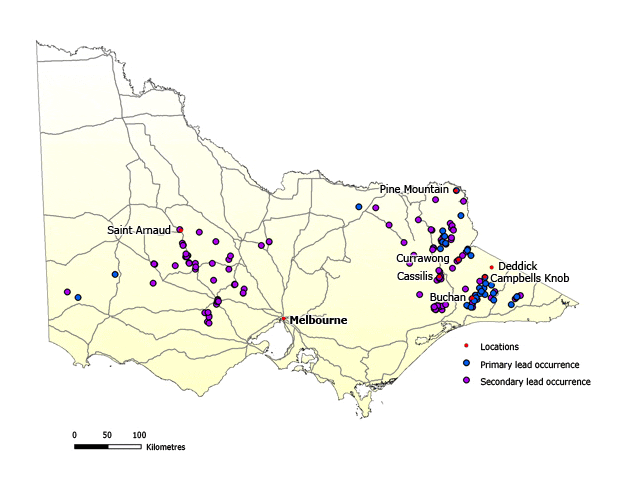Lead

Lead has high density, is corrosion resistant, and can be produced at low cost. It has a wide range of uses including as ballast, in batteries, and as a radiation shield.
Lead mineralisation is widespread in Victoria, but the deposits are small. Recorded production of lead ore amounts to approximately 800 tonnes. Galena (PbS) is the main ore mineral and is commonly found with sphalerite and chalcopyrite.
A few lead deposits have been mined in East Gippsland, notably in the Buchan–Murrindal area, where there are small lenses of galena in limestone. Minor production has also been recorded from Mount Deddick, where there are many parallel lodes of galena-rich quartz veins within a well-developed fracture system in a granite, and from Campbells Knob, which is a similar deposit to that at Mount Deddick, with quartz–galena–sphalerite–chalcopyrite lodes within a complex granodiorite intrusion.
Galena is a major component of most sediment-hosted exhalative volcanogenic deposits. Victorian volcanic-hosted massive sulphide deposits, such as the Currawong zinc-copper deposit, contain minor lead. Lead mineralisation has also been found at Errinundra, and at Pine Mountain where mining targeted fluorite (CaF2).
Galena is associated with gold mineralisation at St Arnaud, Percydale, and in other areas of the western Victorian goldfields, as well as at Omeo, Cassilis and Bethanga in eastern Victoria. The galena is generally associated with silver in these areas.
Further information
Geophysical signatures of base metal deposits in Victoria – Geological Survey of Victoria Report 119
Minerals of Victoria – Geological Survey of Victoria Report 92
Maps
To create your own maps online and in real time, plan exploration activities by viewing land status, or download GIS data to add to your own maps, visit GeoVic.

Page last updated: 12 Jan 2023